
Dave Barlow © Cleveland Naturalists’ Field Club. 7th April 2024



Welcome to Cleveland Naturalists’ Field Club
Gills and Becks: the ancient woodlands of coastal north-east Yorkshire
Gill: Chiefly N English, a deep ravine, especially a wooded one. - ORIGIN Middle English: from Old Norse gil ‘deep glen’.
Beck: N. English a stream. - ORIGIN Middle English: from Old Norse bekkr, of Germanic origin.
(Concise Oxford Dictionary, tenth edition 1999).
Introduction
Established in 1952, the North York Moors National Park is probably best known for containing the largest area of heather moorland in England. Between this and the spectacular Jurassic cliffs of the north-east Yorkshire coastline lies a series of ancient semi-natural woodlands, somewhat hidden away and probably less widely known. Typically these gills stretch inland from the coast like dark emerald fingers, lining steep-sided valleys drained by becks that wind their way predominantly east and north down to the sea. The most northerly is the woodland complex centred on Saltburn-by-the-Sea with others occurring southwards from here as far as the Scarborough area some 30 miles (50km) distant. More lie somewhat further inland.
Table 1 The major ancient semi-natural woodland complexes of the north-east Yorkshire coast
* Beast Cliff differs from other sites in that it occupies a cliff face and ledge on the North Sea coast
Table 2 Some other ancient semi-natural woodlands within 15km of the north-east Yorkshire coast
What follows is an attempt to describe something of the probable origin of these woodlands and their rich and diverse wildlife. However, detailed information on many groups of plant and animal is sparse or scattered and therefore not always easy to assess. Consequently any contributions or comments that could be used to extend or improve this article in the future would be very much appreciated.
Origins
As would be expected, the flora and fauna of these woodlands is much influenced by geology and climate. During the last glaciation the higher parts of north-east Yorkshire were ice free but snow-clad, a tundra landscape surrounded almost entirely by extensive glaciers to the west, north and east. Following this period the retreating ice left behind vast amounts of material, notably sticky red-brown boulder clays, deposits of which can be up to 100m thick. These overlie Jurassic strata including sandstones, ironstones, shales and marls (Kent & Gaunt 1980, Atherden & Simmons 1996). It is through the boulder clays and softer shales that many of the becks have cut their steep-sided valleys. The soils resulting from this geological mix are variable in pH, resulting in a rich and diverse flora (Lawrence, 1990 & 1994). Sheltered from high winds at any season, notably from winter storms, and shady in summer, the gills are protected from extremes of temperature and have their own microclimate. In spite of occurring in a region of relatively low annual rainfall they are often damp underfoot, still and humid.
But how is it that we now have a landscape in this area consisting of a core of open moorland more or less surrounded by farmland and incised by ravines that are wooded? Extensive pollen analysis has shown that following the end of the last glaciation climatic warming led to almost the whole of north-east Yorkshire being clothed in oak forest. This included virtually all of the area that is now heather moorland except for small patches of heath and bog at the highest levels where the woodland cover thinned out (Atherden 1992). It appears that as early as 7,000 years BP Mesolithic peoples began enlarging these natural areas of heath by cutting and burning the undergrowth, perhaps initially to create open areas favoured by game and later for use as agricultural land. When soil nutrients became exhausted more areas were cleared and from that time onwards a combination of burning and grazing pressure served to prevent woodland regeneration across an ever increasing area. The causes of vegetation change in the past are not simple and, in addition to human activity, climatic fluctuations are thought to have played a part . Pollen analysis of peat cores indicate that there was a major impact on forest cover in this area during the Iron Age when farming increased in scale and timber was required for smelting locally obtained iron ore (Atherden 1999 and references therein). By medieval times the uplands were used extensively for sheep grazing. This continued up to the modern era when, coupled with the onset of management for grouse shooting, it resulted in a very large expansion of the heather moorland that we see today. Hence the gills that remain appear to be the fragmented descendants of the original forest cover that have survived often in steep-sided valleys too inaccessible either for agricultural use or for timber to be extracted to the point where woodland cover was lost. The conclusion drawn from surveys carried out by the Nature Conservancy Council (currently Natural England) is that these are ancient semi-natural woodlands i.e. they have been in continuous existence since at least 1600AD but probably for much longer (Carter, 1987a & 1987b; Cooke 1987).
These woodlands are significant for a number of reasons. They are of high biodiversity and in a regional context they have a number of widely differing species associated with them. In addition their microclimate, as described earlier, has a significant impact on their species composition.
To be more precise, some of the species occurring in these woods possess one or more of the following features:
a degree of association with ancient semi-natural woodland, at least locally,
they appear to be regionally or nationally scarce,
they are able to survive (or even thrive) here as a result of the moist, sheltered microclimate,
interestingly, at least a few species have an otherwise predominantly westerly or north-westerly distribution in Britain.
To consider each of these points in turn would not be easy because many species of interest fall into more than one of the above categories. Hence what follows is in part a general attempt to illustrate these aspects by reference to selected species groups.
Flora
The dominant tree in more acid conditions is Oak (Quercus sp.) but in woodlands where soils are more intermediate Oak and Ash (Fraxinus excelsior) are co-dominant, most Oaks perhaps best being considered as hybrids i.e. Quercus x rosacea (Sykes 1993, Lawrence 1994). Other widespread tree species include Sycamore (Acer pseudoplatanus), Birch (Betula pendula), Beech (Fagus sylvatica) and the occasional Small-leaved Lime (Tilia cordata), with an understorey of Hazel (Corylus avellana), Holly (Ilex aquifolium), Blackthorn (Prunus spinosa), Hawthorn (Crataegus monogyna ), Elder (Sambucus nigra), Wych Elm (Ulmus glabra) and Alder (Alnus glutinosa). In more alkaline conditions, for example in Mulgrave, Roxby and Saltburn Woods, Spindle (Euonymus europaeus) can be found, a shrub not common in this region.
There is possibly no such thing as a species entirely restricted to ancient semi-natural woodland throughout Britain but regionally such associations can exist to a greater or lesser extent. Flora showing some association with the woodlands in question include Greater Woodrush (Luzula sylvatica) and Wood-sorrel (Oxalis acetosella) in more acid sites; the former occurs extensively in Newton Wood and at Hayburn Wyke.
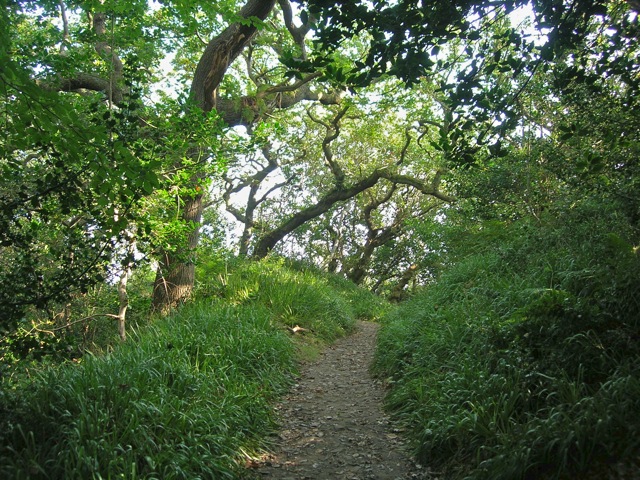
On more basic soils major components of the herb layer can include Pendulous Sedge (Carex pendula), as at Mulgrave Woods where the flower spikes can reach 2m in length, and Woodruff (Galium odoratum). Wood anemone (Anemone nemorosa) is another widespread species of these woodlands, sometimes carpeting very large areas for example throughout much of Oakrigg Wood.
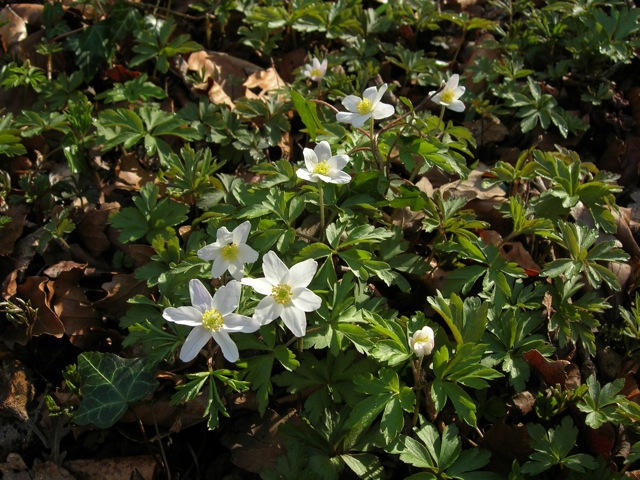
In this region it seems to have a strong association with ancient semi-natural woodland although it can sometimes be found in open sites, perhaps where it has been able to survive the removal of trees. Other herbaceous plants showing an association to some extent include Wood Speedwell (Veronica montana), Toothwort (Lathraea squamaria) and Broad-leaved Helleborine (Epipactis helleborine). Greater Butterfly Orchid (Platanthera chlorantha) and Birds-nest Orchid (Neottia nidus-aves) are present but of rare occurrence.
The damp shady conditions which prevail in these woods provide a habitat in which ferns are able to thrive. Hart’s Tongue (Asplenium scolopendrium) can be both luxuriant and abundant as at Hazel Grove near Saltburn where the fronds can be up to 0.6m long.
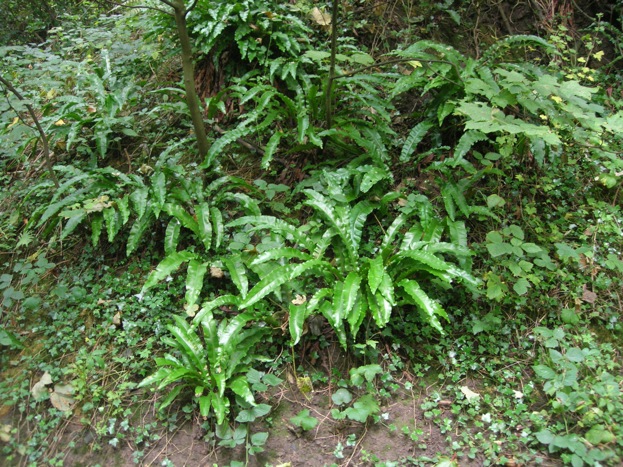
Soft Shield Fern (Polystichum setiferum) is widespread and can also grow to a considerable size in base rich habitats. Hard Shield Fern (P. aculeatum) is more local in occurrence and Narrow Buckler Fern (Dryopteris carthusiana) can be encountered occasionally, for example in Mulgrave Woods.
Patterns and Diversity
The Killarney Fern (Trichomanes speciosum) illustrates another point of interest and significance about these woodlands. The sporophyte generation grows in acidic, rocky situations, often in deep shade.
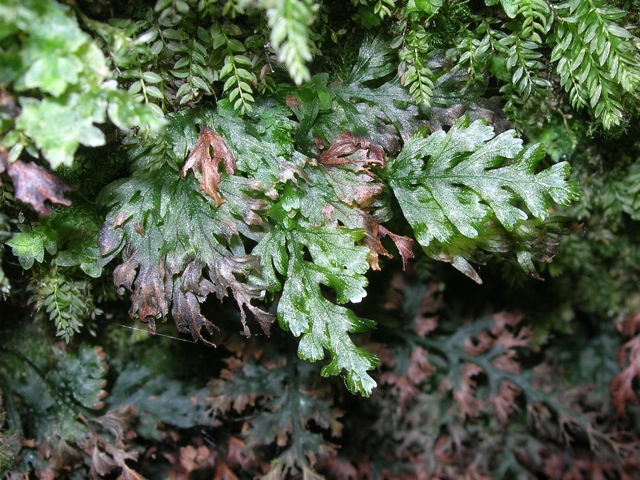
It requires shelter from low temperatures and needs constant high humidity. This fern is predominantly western in its distribution in the British Isles (www.bsbimaps.org.uk/atlas/map_page.php?spid=2075.0), Merryweather & Hill (1992) having described it as occurring at just one location in England. Subsequently it has been recorded from a number of additional sites during surveys carried out by the Botanical Society of the British Isles, including no less than twelve 10km squares in north-east Yorkshire, predominantly towards the coast. Most of these records are however for the gametophyte which is unusual in being filamentous, mat-forming and perennial to the point of seemingly living in almost suspended animation. It inhabits the dimmest recesses of crevices beneath overhanging rocks at light intensities beyond the limits of bryophyte growth (Rumsey et al. 1991).
Interestingly, this distribution pattern whereby a chiefly western or north-western species occurs in the ancient woodlands of coastal north-east Yorkshire can be seen in a number of other, very different plant and animal groups. Examples include Rustwort (Nowellia curvifolia), a leafy liverwort, typically with dark reddish stems, that forms colonies on decaying logs. Other bryophytes with a similar distribution pattern, some of which occur in more open upland habitats but at least partly in woodlands in north-east Yorkshire, include the liverworts Riccardia palmata, Bazzania trilobata and Harpanthus scutatus and the mosses Seligeria recurvata, Tortula freibergii, Hookeria lucens and Heterocladium heteropterum (Atherton et al. 2010). Of these, Blackburn (2007) describes north-east Yorkshire as a stronghold for Tortula freibergii. Although there is possibly no such thing as a bryophyte entirely restricted to old woodland, the sites in question are undoubtedly rich in species of moss and liverwort (see e.g. Blackburn 2000 & 2007, Blackburn & Blockeel 2000, Blockeel & Blackburn 2007).
Two lichens, Pertusaria papillaris ( formerly Lecidia cinnabarina) and Thelotrema lepidinum, considered to be old woodland indicators (Marren 1990) have a similar distribution pattern, although occurring in the south of Britain as well as predominantly in the west.
Among fungi, over 200 species have been recorded from the Saltburn Gill area alone, including the Willow Shield (Pluteus salicinus). In spite of its name it is said to occur more frequently on Ash and Beech (Buczacki 2012). In all, some ten members of this genus have been recorded in these coastal woodlands, a group thought to be associated with old woodland (Marren 2012). The widespread but fairly uncommon Scarlet/Ruby Elfcup complex (Sarcoscypha spp.) is known to occur in at least six woodlands in the area.
Continuing with the theme of species requiring damp, sheltered conditions, the terrestrial molluscan fauna of these woodlands is particularly rich compared with sites elsewhere in Britain. Well over 40 species have been recorded at some sites, which represents a third or more of the British fauna (Wardhaugh 1996, 1997, 2005 and unpublished data). The snails Leiostyla anglica, Spermodea lamellata and Zenobiella subrufescens are largely western in distribution in the British Isles but all have strongholds in the woodlands of north-east Yorkshire (Kerney 1999, Wardhaugh 2011). All three species are in decline nationally, with most of their global population occurring in the British Isles. All are at least to some extent associated with ancient semi-natural woodland in Britain, most notably Spermodea lamellata (Kerney & Stubbs 1980, Wardhaugh 2000).

The slug Limax cinereoniger shows a similar but less marked distribution pattern (Wardhaugh 2014a).
Several myriapod species of interest have been recorded in these woodlands. The centipede Lithobius curtipes occurs for example in Mill Bank Wood, Kildale. A scarce species, it is known to be associated with ancient woodland (Barber & Keay 1988). Strigamia acuminata, known from three sites, is a geophilid centipede associated with woodland and wetland and at the northern limit of its range in this region. Of the millipedes, the nationally uncommon Craspedosoma rawlinsii, associated with high humidity microhabitats, is known from several sites. Chordeuma proximum
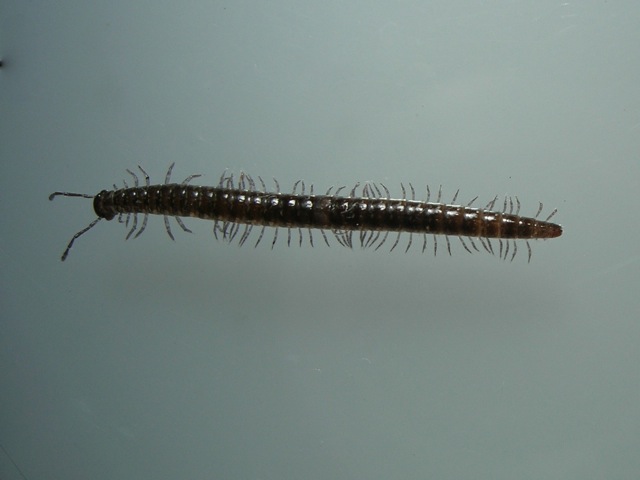
which has a southerly and westerly distribution in Britain and a strong association with woodland was found at four sites in 2013, well outside its previously known distribution (Wardhaugh 2014b). Allajulus nitidus, a nationally uncommon species has also been found at two sites recently. Interestingly, in Britain it seems to be somewhat synanthropic but elsewhere in Europe it is known to be associated with deciduous woodland (Blower 1985, Lee 2006 and references therein).
The ancient woodlands of north-east Yorkshire have long been known as hot spots for Coleoptera; sites such as Forge Valley and Mulgrave Woods have been of much interest in the past but there seems to have been little recent intensive recording (B Marsh pers. comm.). Over 200 species are known form Mulgrave Woods and over 400 from Forge Valley but many of these records are not recent, most dating from the second quarter of the 20th century. Beetle species of interest recorded in more recent times from the woodland area as a whole include the Net-winged Beetle Pyropterus nigroruber (Kennington & Denton 2007), also the Rhinoceros Beetle (Sinodendron cylindricum) and the Boat-shaped Fungus Beetle (Scaphidium quadrimaculatum).
Marren (1990) provides a list of Lepidoptera thought to be associated with ancient semi-natural woodland in the south of England. Unfortunately very few of these occur in the north at all, making assessment of the relative importance of the woodlands in question less easy. Blomer’s Rivulet (Discoloxia blomeri) is a moth species associated with old woodland that has a westerly distribution in England but a local stronghold in north-east Yorkshire, being known for example from Saltburn Gill (Peter Waterton pers. comm.), Newton Wood and the Staithes area woods (Frost 2013) The Scarce Prominent (Odontosia carmelita) is another woodland species known from this area. It has a somewhat disjunct distribution, being common in the south and present in Scotland. The predominantly southern and locally scarce Pinion-streaked Snout (Shrankia costraestrigalis), Red Underwing (Catocala nupta) and Yellow-barred Brindle (Acasis viretata) have all been recorded in these woodlands in the recent past (Paul Forester pers. comm.).
Concerning bird life. Joynt, Parker & Fairbrother (2008) make the following statement with regard to woodlands in the Cleveland (i.e. northern) part of the area under consideration. “These East Cleveland becks hold vitally important breeding populations of woodland and riparian species, such as green woodpecker, kingfisher, dipper, grey wagtail, tree pipit, nuthatch and spotted flycatcher and raptors, including goshawk, sparrowhawk and kestrel.” Some classic species of western oak woods have bred in this region, such as the Wood Warbler (Phylloscopus sibilatrix), Redstart (Phoenicurus phoenicurus) and Pied Flycatcher (Ficedula hypoleuca) but in line with national trends all three appear to have declined significantly since the third quarter of the 20th century (this in spite of some recent national recovery in numbers of the Redstart). This is not easy to explain given the fact that the habitat seems unchanged.
Why are there a few species of widely differing taxa that have strongholds in the north-east Yorkshire coastal woodlands (or at least which occur here) but otherwise have a westerly or north-westerly distribution in Britain? The reason may well be climatic, their presence being dependent upon a sufficiently moist and humid habitat, conditions more prevalent in the west but also provided by these north-east Yorkshire woodlands. Another contributing factor might be lack of disturbance, this being provided by woodlands which appear to have a history of long continuous tree and/or ground cover; continuity being the key feature. Thus absence from ancient woodlands in the south and east could be climatic or it could perhaps be a consequence of past traditional management involving periodic clearance and drying out of the ground layer. In some instances ancient semi-natural woodlands in the south appear to have been established on former farmland for example Madingley Wood in Cambridge overlies an Iron Age field system but now has the appearance of a fully developed ancient wood and what may be a planned field system extends under the Blean Woods of Canterbury (Rackham, 2006). Moisture loving species with very poor powers of dispersal may never have been able to colonize such sites in spite of their antiquity.
Management and conservation
Having survived to the present day apparently almost by default, these ancient woodlands generally show few signs of past management regarded as traditional elsewhere, notably in the south of England, such as the presence of a boundary ditch and bank, boundary pollards or evidence of systematic coppicing, as described by Rackham (2006). With respect to coppicing, Cooke (1987) states “Reports of coppice stools being present are not infrequent but in many cases these seem to be the result of irregular cutting rather than traditional woodland management.” Thus, for example, a Tees Valley Wildlife Trust leaflet of about 2000 describing Saltburn Gill states that “little coppicing has been carried out over the last few hundred years therefore allowing the woodland to develop naturally.” There are some formerly coppiced limes in parts of the Kilton Woods complex (Whitecliff Wood NZ7118 and Clarkson‘s Wood NZ7018) some of which are estimated to be over 500 years old (Allen 2007) and a few of very considerable size at Hayburn Wyke.
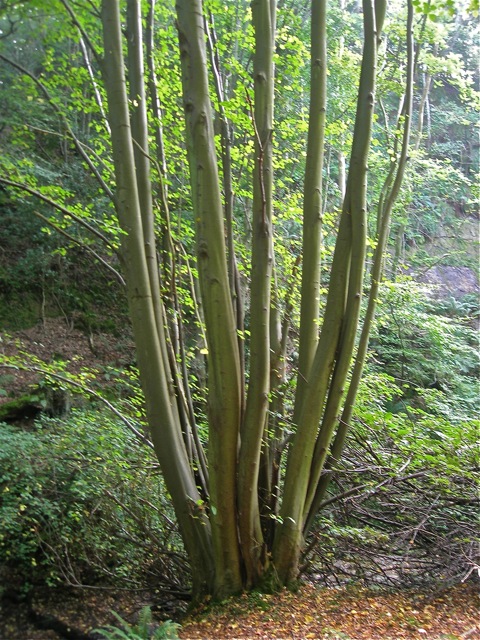
Within the region there are seven areas of ancient semi-natural woodland which are designated as Sites of Special Scientific Interest (SSSI) and for which the citations and views about management (VAM) are currently available on the Natural England website. The citations are site specific but the VAM are generic. One version of the latter is used for sites lying at a slightly lower range of altitudes (very approximately (10 to 130m). The other covers four sites of range approximately 60 to 190m. The first version states “Felling, thinning or coppicing may be used to create or maintain variations in the structure of the wood” with the preceding caveat, “Not all of the management principles will be appropriate to all parts of the SSSI.” Somewhat in contrast, the other VAM document implies that coppicing may be inappropriate for the four woods in question: “In some woods it may be appropriate to re-introduce coppicing, for example if a wood has very good butterfly populations that would benefit from an increase in more open, light conditions. However, re-introducing coppicing will certainly not be suitable for all woodlands. In most cases the retention of high forest, with its more complex structure and rich moss and lichen communities, will be the best form of management.” Marren (1990), in his inimitable way, provides the reasoning behind the latter point, "The loss of protective woodland canopy, either by clear-felling or by coppicing, exposes the bryophytes to the scorching of the sun with the result, even in the humid west, that many of the mosses and nearly all the liverworts immediately curl up and die."
Two sites owned by the Woodland Trust have management policies of minimum intervention (Cow Close Wood NZ7014 and Hagg Wood NZ6815) as is the case for Saltburn Gill, owned by the Tees Valley Wildlife Trust. These have management limited very largely to the control of Sycamore, either by ring barking to provide dead standing timber or by removal on a piecemeal basis, rather than widespread felling which would result in loss of shelter below the canopy. In contrast, the management plan for five woodlands making up part of the Loftus and Kilton complex (Table 1), owned by Redcar and Cleveland Council, favours some coppicing and creation of open areas (Spencer 2008).
Conclusion
In summary, this article is intended as no more than an initial attempt to draw together some information about these woodlands and to highlight their value for wildlife. For this reason any additional material or comments would be much appreciated, perhaps especially about plant or animal groups not mentioned, other woodland species of interest present which show (or do not show) an otherwise north-westerly distribution, or any aspects of management. Species lists for some of the coastal woodlands of north-east Yorkshire can be found elsewhere on Cleveland Naturalists’ Field Club website. These include sites in the Saltburn area (Hazel Grove, Rifts Wood and Saltburn Gill), and the Skinningrove and Loftus area (Rosecroft Wood and Whitecliff Wood).
Acknowledgements
I am grateful to the following for their help in providing information and comments included in this article. Vic Fairbrother (birds), Paul Forster and Peter Waterton (moths records for Saltburn Gill); Jeremy Garside, Tees Valley Wildlife Trust (Management Plan and species data, Saltburn Gill); Vince Jones, (for introducing me to the ferns of East Arnecliff Wood, notably Trichomanes speciosum and Hymenophyllum tunbrigense); Bob Marsh (comments on Coleoptera, especially those of Forge Valley, Mulgrave Woods and the Saltburn area); Neil Thirkell, Redcar & Cleveland Council (Management Plans for the Loftus Woods complex).
The following have been kind enough to read and comment on some or all of this article. Malcolm Birtle, Vic Fairbrother, Paul Forster and Peter Waterton. Any remaining inaccuracies are however entirely my own.
Lastly I would like to thank my wife Moira for reading and commenting on this article but especially for her company on countless expeditions to Yorkshire woodlands and her help in seeking out some of their more obscure invertebrate fauna.
A A Wardhaugh, March 2015.
References
Allen, M. (2007) Whitecliff Wood and Clarkson’s Wood. Cleveland Naturalists’ Field
Club Record of Proceedings 9: 2-3.
Atherden, M. (1992) Upland Britain A natural history. Manchester University Press.
Atherden, M. (1999) The vegetation history of Yorkshire: a bog-trotter’s guide to God’s
own country. Naturalist 124: 137-156.
Atherden, M. & Simmons, I.G. (1996) The Landscape, in The North York Moors
Landscape Heritage eds. D A Spratt & B J D Harrison. North York Moors National
Park, Helmsley.
Atherton, I., Bosanquet, S., & Lawley, M. (2010) Mosses and Liverworts of Britain and
Ireland. British Bryological Society.
Barber, A.D. & Keay, A.N. (1988) Provisional Atlas of the Centipedes of the British
Isles. Biological Records Centre, Huntingdon.
Blackburn, J.M. (2000) Yorkshire Naturalists’ Union Excursions in 1995. Falling Foss,
near Whitby. Bryology. Naturalist 125: 177-178.
Blackburn, J.M. (2007) Yorkshire Naturalists’ Union Excursions in 2006. Hayburn
Wyke. Bryology. Naturalist 132: 132.
Blackburn, J.M. & Blockeel, T.L. (2000) YNU Bryological Section: Annual Report
1998-1999. Naturalist 125: 77-79.
Blockeel, T.L.& Blackburn J.M. (2007) Report of Yorkshire Naturalists’ Union
Bryological Section : 2004-2006. Naturalist 132: 61-68.
Blower, J.G. (1985) Millipedes. Keys and notes for the identification of the species. E J
Brill, London.
Buczacki, S. (2012) Collins Fungi Guide. Collins, London.
Carter, A. (1987a) North Yorkshire inventory of Ancient Woodland Part 2: Harrogate,
Hambleton, Selby and York (Provisional). Nature Conservancy Council, Peterborough.
Carter, A. (1987b) North Yorkshire inventory of Ancient Woodland Part 3: Ryedale and
Scarborough (Provisional). Nature Conservancy Council, Peterborough.
Cooke, R. (1987) Cleveland inventory of Ancient Woodland (Provisional). Nature
Conservancy Council, Peterborough.
Frost, H.M. (ed.) (2013) Yorkshire Butterflies and Moths 2012. Butterfly Conservation,
Wareham and Yorkshire Naturalists’ Union, York.
Joynt, G., Parker, E.C. & Fairbrother, J.V. (2008) The Breeding Birds of Cleveland.
Teesmouth Bird Club.
Kennington, F.E. & Denton, M. L. (2007) Yorkshire Naturalists’ Union Excursions in
2006. Hayburn Wyke. Coleoptera. Naturalist 132: 131.
Kent, P. & Gaunt, G.D. (1980) British Regional Geology, Eastern England from the Tees
to the Wash, 2nd ed. HMSO, London.
Kerney, M.P. (1999) Atlas of the Land and Freshwater Molluscs of Britain and Ireland.
Harley Books, Colchester.
Kerney, M.P. & Stubbs, A. (1980) The Conservation of Snails, Slugs and Freshwater
Mussels. Nature Conservancy Council, Peterborough.
Lawrence, I. (1990) A flora of Cleveland and some aspects of the plant distribution.
Naturalist 115: 3-6.
Lawrence, I. (1994) A Guide to the Wild Flowers of Cleveland. Cleveland County
Council.
Lee, P. (2006) Atlas of the Millipedes (Diplopoda) of Britain and Ireland. Pensoft, Sofia-
Moscow.
Marren, P. (1990) Britain’s Ancient Woodland. Woodland Heritage. David & Charles,
London.
Marren, P. (2012) Mushrooms. British Wildlife Publishing, Gillingham.
Merryweather, J. & Hill, M. (1992) The Fern Guide. An introductory guide to the ferns,
club mosses, quillworts and horsetails of the British Isles. Field Studies 8: 101-188.
Spencer, D. (2008) Loftus Wood Management Plan, 2008 - 2013. Unpublished document,
Redcar and Cleveland Council.
Sykes, N. (1993) Wild Plants and their Habitats in the North York Moors. North York
Moors National Park.
Rackham, O. (2006) Woodlands. HarperCollins, London.
Rumsey, F.J., Headley, A.D., Farrer, D.R. & Sheffield, E. (1991) The Killarney Fern
(Trichomanes speciosum) in Yorkshire. Naturalist 116: 41-43.
Wardhaugh, A.A. (1996) The terrestrial molluscan fauna of some woodlands in north east
Yorkshire, England. Journal of Conchology 35: 313-327.
Wardhaugh, A.A. (1997) The terrestrial molluscan fauna of some woodlands in north
east Yorkshire, England: a framework for quality scoring and association with old
woodland flora. Journal of Conchology 36: 19-30.
Wardhaugh, A.A. (2000) Terrestrial molluscs associated with ancient woodland in north-
east Yorkshire. The Conchologists’ Newsletter 9: (no.155) 425-428.
Wardhaugh, A.A. (2005) The land and freshwater Mollusca of Airy Holme Wood, north-
east Yorkshire. Naturalist 130: 99-104.
Wardhaugh, A.A. (2011) The Scarborough Snail and what it has to tell us about ancient
woodland. British Wildlife 22: 176-183.
Wardhaugh, A.A. (2014a) Limax cinereoniger (The Ash-black Slug) in Cleveland.
Cleveland Naturalists’ Field Club Record of Proceedings 10 (4): 21-29.
Wardhaugh, A.A. (2014b) The millipede Chordeuma proximum in Yorkshire: a new
county record. Naturalist 138: 208-209.
|
Woodlands |
Coastal area on which drainage converges |
|
Hazel Grove; Saltburn and Skelton Woods; Saltburn Gill |
Saltburn-by-the-Sea (NZ6621) |
|
Gerrick, Moorsholm, Kilton and Loftus Woods |
Skinningrove (NZ7119) |
|
Easington, Roxby and Oakrigg Woods |
Staithes (NZ7818) |
|
Mulgrave Woods |
Sandsend (NZ8612) |
|
Ramsdale Beck and Stoup Beck Woods |
Robin Hood’s Bay (NZ9503 & NZ9504) |
|
Beast Cliff* |
near Ravenscar (TA0099) |
|
Hayburn Beck area |
Hayburn Wyke (TA0197) |
|
Woodlands |
Location |
|
Newton and Airy Holme Woods |
Great Ayton (NZ5610) |
|
Mill Bank and South Woods |
Kildale (NZ6010) |
|
Woodlands of the Rivers Esk and Murk Esk in the Glaisdale, Grosmont and Goathland areas |
Grosmont (NZ8205) |
|
Woodlands of the May Beck and Little Beck areas |
Little Beck (NZ8704) |
|
Hackness and Forge Valley Woods |
Hackness (SE9690) to East Ayton (SE9985) |
Loading...
Here you can find a Google map of the locations mentioned in the article by Tony Wardhaugh. You can also find a copy of the article in PDF format here